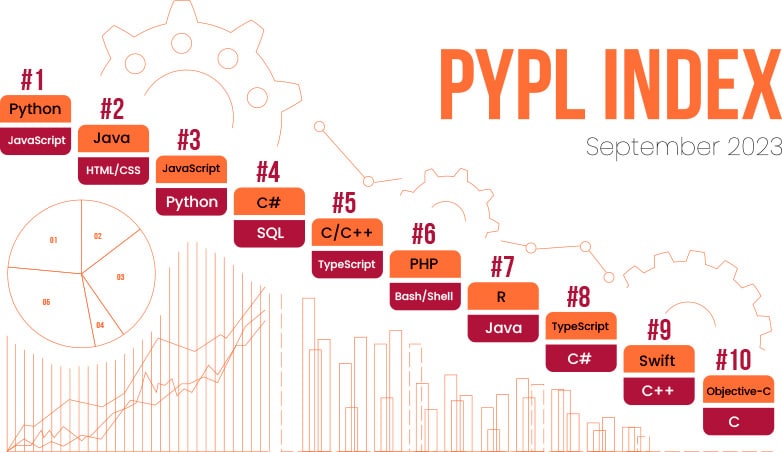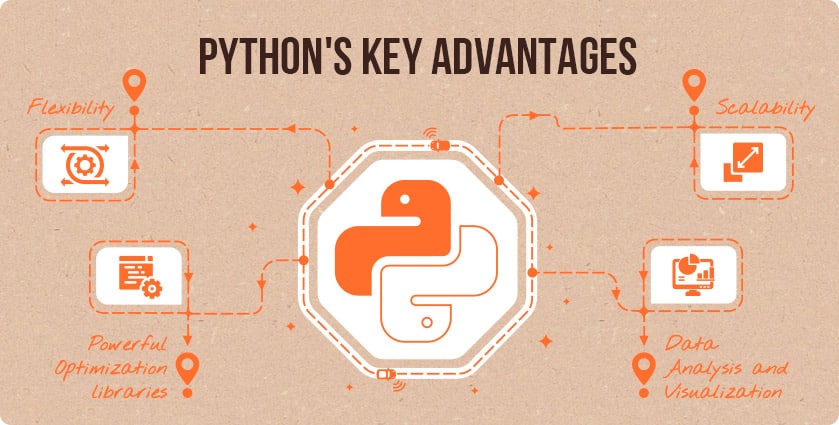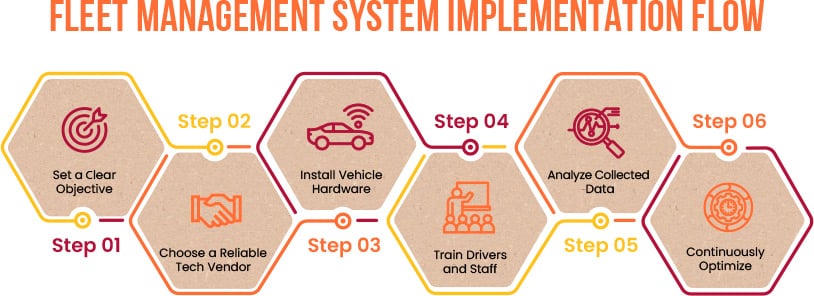
The success of transportation and logistics companies is defined by how efficiently their fleet operates. This includes vehicle tracking, route optimization, driver management, and maintenance. Managing all these aspects manually is either impossible or time-consuming. To address the challenges, companies often use Python telematic solutions which are the part of the Internet of Things (IoT) domain.
In this article, we will talk about how exactly the telematic systems work and why Python capabilities are a good fit for such systems. For now, let’s just mention that according to the PYPL index, Python is the number one programming language among developers.
We will also enlighten how to implement the fleet management system, what benefits Python telematic systems provide to transportation and logistics companies, and share with A-Team Global’s expertise in this area.
Let’s begin with an introduction to Python.

What is Python and what are its key advantages?
Python is an object-oriented (based around instances of classes), high-level (easy to understand by humans) scripting programming language. Python provides developers with the following core advantages:
Powerful optimization libraries. Python has a wide range of optimization libraries, such as PuLP, SciPy, CVXPY, and others allowing developers to efficiently solve optimization tasks. A set of algorithms and functionalities provide engineers with the ability to leverage different methods: linear programming, integer programming, quadratic programming, and more.
Data analysis and visualization. Python supports the processing of the Global Positioning System (GPS) data, analysis of metrics like mileage and fuel consumption, and others. All processed data can be visualized via informative, customized, and appealing plots making it easy to read and analyze.
Flexibility. Python is capable of accommodating a wide range of programming styles, paradigms, and tasks. The language offers developers the freedom to choose from multiple approaches to problem-solving, enabling them to adapt their code to suit different requirements and preferences. Python can connect to various APIs, databases, and other sources. Also, the language supports different programming paradigms such as procedural, object-oriented, and functional programming.
Scalability. Python is capable of handling increasing workloads and growing seamlessly with the demands of a project or application. The language enables developers to design scalable solutions for a wide range of use cases, from small scripts to large-scale web applications and distributed systems. The scalability ensures optimal performance and efficiency, allowing projects to evolve and expand without compromising stability or maintainability.

How Python can solve a Vehicle Routing Problem and facilitate fleet management?
Python comes in handy when it is necessary to solve the Vehicle Routing Problem (VRP) and elaborate on fleet management solutions. VRP is related to creating optimal routes for multiple vehicles so they arrive at all required locations. As to fleet management,
Python offers various libraries and frameworks that provide tools for modeling, solving, and visualizing VRP instances. Let’s see how Python is commonly used for VRP:
Data acquisition
Python can collect vehicle data from various sources, including onboard diagnostics (OBD) ports, GPS devices, sensors, and telematics platforms. Libraries such as PySerial and python-OBD establish connections with OBD-II interfaces for retrieving vehicle diagnostics data.
Machine learning
Python includes such machine learning libraries as scikit-learn, TensorFlow, and PyTorch. The libraries allow software engineers to develop predictive models and machine learning algorithms in telematics applications. These models and algorithms enable driver behavior analysis, anomaly detection, predictive maintenance, and fuel efficiency optimization.
Web development
To manage vehicle data, operators use dashboards, portals, and web applications. To create such interfaces, Python supports such web frameworks as Django and Flask. These frameworks provide tools for building RESTful APIs, user authentication, data visualization, and integration with other systems.
Real-time processing
Using Python, developers can process telematics data streams in real-time. This allows developers to monitor vehicle data, detect events, and trigger actions. Libraries such as Kafka, RabbitMQ, and Celery assist in real-time message queuing, event processing, and task scheduling in telematics systems.
Integration
Python is a flexible and integration-friendly language. It is well-suited for integrating telematics systems with other software applications and services. Developers use Python to integrate telematics data with enterprise fleet management systems and third-party APIs.
Modeling the VRP
Python allows developers to model the VRP using mathematical formulations or high-level abstractions. They can represent the problem by defining parameters, decision variables, constraints, and the objective function. This modeling process involves creating an abstraction of the problem that can be understood by optimization solvers.
Integration with optimization libraries
Python provides access to powerful optimization libraries such as OR-Tools, PuLP, and SciPy. These libraries offer algorithms and solvers for solving various optimization problems, including VRP. Developers can leverage these libraries to implement and solve VRP models efficiently.
Using OR-Tools for VRP
Developers successfully use OR-Tools library due to Python bindings to solve VRP instances. The library supports a dedicated module for vehicle routing which includes algorithms for solving different variants of the VRP such as:
- Capacitated VRP (CVRP)
- VRP with Time Windows (VRPTW)
- VRP with Pickup and Delivery (VRPPD)
Implementing heuristic and metaheuristic algorithms
To solve VRP instances, developers use Python’s capabilities to execute heuristic and metaheuristic algorithms. To name a few, it can be the Clarke-Wright Savings Algorithm or Sweep Algorithm. They can provide approximate calculations. For more accurate results, there are Genetic Algorithms and Simulated Annealing metaheuristic algorithms available.
Visualization and analysis
Python possesses such data visualization libraries as Matplotlib, Seaborn, and Plotly allowing developers to visualize VRP results. With its’ help, engineers can create interactive maps, plots, and charts. Data visualization helps managers to conveniently estimate such factors as travel and distance time, time windows, vehicle capacities, delivery priorities, and others. Thus, they can make data-based and informed decisions to solve VRP.
Integration with Geographic Information Systems (GIS)
When solving VRP, it is essential to consider geographical factors. This is when GIS libraries (GeoPandas, Shapely, Folium, etc.) come on the scene. They can help in solving VRP by:
- Handling spatial data
- Geocoding
- Road network analysis
- Route visualization
- Spatial constraints analysis
All these data essentially improve the accuracy of VRP solutions and allow managers to make optimal decisions quickly.
How to implement a fleet management system?

Implementation of a fleet management system requires a thoughtful approach. We prepared a general flow that will help you understand the scope of work for the implementation.
Set a сlear objective
We already know Python telematics solutions can serve a set of different advantages for transportation companies. If your budgets are tight, you should prioritize your business needs and define the exact telematic solution you need first.
Select the right software
Phyton telematic systems are sophisticated. It requires specific tech expertise from a software provider to ensure flawless and accurate work of such solutions. Choose your tech vendor carefully. Make sure it has a solid background in the development of Python telematic systems; specifically, that aligns with your needs.
Install vehicle hardware
To transmit data about vehicle location, performance diagnostics, fuel usage, and other metrics, you have to install telematic devices on it. There are a lot of different manufacturers of telematic devices, so it’s important to consult with a tech expert. The expert will help you to choose the right device for your fleet ensuring the hardware can seamlessly integrate to your software platform.
Train drivers and staff
Educate your drivers and staff on how the telematic system works, and how to navigate it via mobile applications. Explain to your staff the purposes of the technology. Convey the idea of the importance of careful driving, and the necessity of following alert notifications of the system if that happens. Provide them with manuals so they can find all the required information anytime.
Analyze collected data
With the help of intelligent dashboards and analytic tools monitor telematic data and make adjustments to route optimization if necessary, monitor vehicle health, and schedule timely maintenance of your fleet. Create reports and identify areas for improvement.
Continuously optimize
Continuously evaluate and refine the analysis process based on feedback, new data, and changing business requirements. Iterate on the analysis techniques, models, and strategies to improve accuracy, efficiency, and effectiveness over time. Derive valuable insights from real-time vehicle tracking data to optimize operations, improve efficiency, enhance safety, and achieve business objectives.
Python telematic solutions by A-Team Global
A-Team Global is an IoT-focused software development company. We have been providing IoT-based solutions for different industries including transportation and logistics for more than 10 years.
A-Team Global have a pool of tech-savvy software engineers specifically nailed in Python language. As an IoT software development company, we create telematic solutions from scratch or help companies maintain their existing projects.
Our clients can choose the model of collaboration from the following options:
- Outsourcing software development services that allow businesses to assign their project to our team to work remotely.
- Staff augmentation services that allow businesses to reinforce their in-house team to work remotely or in their office.
We successfully delivered fleet management projects for clients in Europe both in private and government sectors.
The bottom line
As a functional, scalable, and flexible programming language, Python helps software engineers to develop comprehensive telematic solutions. The solutions are recognized by transportation and logistics companies as efficient options to reduce costs and increase operational performance. With Python telematic systems, companies solve VRP, improve customer satisfaction and drivers’ safety, and enhance overall fleet management.
Considering telematic systems are sophisticated, companies must choose a software provider that possesses a solid background in developing such solutions. With a reliable tech vendor, transportation and logistics companies can move their business to the next level.
you may also want to read

Leveraging Local LLMs and Secure Environments to Protect Sensitive Information
In the rapidly evolving digital landscape, businesses are increasingly adopting Generative AI (GenAI) technologies to stay competitive and innovate. Large...

Boost Efficiency Today: Easy AI Integration for Immediate Results
In the past, the idea of integrating artificial intelligence into your business might have felt like venturing into uncharted territory—complex,...

A Roadmap to Gen AI Adoption for Small and Medium Businesses
Unlock new opportunities by integrating Generative AI into your business operations. In today’s fast-paced digital landscape, small and medium businesses...
